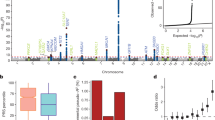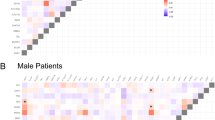Abstract
As a key component of the transforming growth factor-β (TGF-β) pathway, SMAD3 plays an essential role in development and maintenance of self-tolerance. Furthermore, a recent study based on gene-expression profiling in donors of allogeneic hematopoietic cell grafts revealed that the level of expression of several components of the TGF-β pathway can predict the occurrence of graft-versus-host disease (GVHD) in recipients. The gene with the best GVHD predictive accuracy was SMAD3: no recipients suffered from GVHD when their donor cells expressed high levels of SMAD3 transcripts. The present study had two specific aims: to validate differential expression of SMAD3 transcripts in an independent and larger cohort of subjects and to determine whether interindividual differences were dictated by cis-acting genetic elements. In a cohort of 397 subjects, we found that SMAD3 transcript levels varied over a sixfold range. Analyses of SMAD3 single nucleotide polymorphisms and of SMAD3 promoter methylation patterns provide compelling evidence that interindividual differences in SMAD3 transcript levels do not result from in-cis genetic variations. Of note, part of the variance in SMAD3 expression was gender related as women expressed lower levels of SMAD3 transcripts than men.
This is a preview of subscription content, access via your institution
Access options
Subscribe to this journal
Receive 6 digital issues and online access to articles
$119.00 per year
only $19.83 per issue
Buy this article
- Purchase on Springer Link
- Instant access to full article PDF
Prices may be subject to local taxes which are calculated during checkout



Similar content being viewed by others
References
Massagué J, Seoane J, Wotton D . Smad transcription factors. Genes Dev 2005; 19: 2783–2810.
Yang YC, Piek E, Zavadil J, Liang D, Xie D, Heyer J et al. Hierarchical model of gene regulation by transforming growth factor β. Proc Natl Acad Sci USA 2003; 100: 10269–10274.
Shi Y, Massague J . Mechanisms of TGF-β signaling from cell membrane to the nucleus. Cell 2003; 113: 685–700.
Feng XH, Derynck R . Specificity and versatility in TGF-β signaling through Smads. Annu Rev Cell Dev Biol 2005; 21: 659–693.
Massagué J . How cells read TGF-β signals. Nat Rev Mol Cell Biol 2000; 1: 169–178.
Dong M, Blobe GC . Role of transforming growth factor-β in hematological malignancies. Blood 2006; 107: 4589–4596.
Kalies K, Blessenohl M, Nietsch J, Westermann J . T cell zones of lymphoid organs constitutively express Th1 cytokine mRNA: specific changes during the early phase of an immune response. J Immunol 2006; 176: 741–749.
Classen S, Zander T, Eggle D, Chemnitz JM, Brors B, Buchmann I et al. Human resting CD4+ T cells are constitutively inhibited by TGFβ under steady-state conditions. J Immunol 2007; 178: 6931–6940.
Li MO, Wan YY, Sanjabi S, Robertson AK, Flavell RA . Transforming growth factor-β regulation of immune responses. Annu Rev Immunol 2006; 24: 99–146.
Marie JC, Liggitt D, Rudensky AY . Cellular mechanisms of fatal early-onset autoimmunity in mice with the T cell-specific targeting of transforming growth factor-β receptor. Immunity 2006; 25: 441–454.
Li MO, Sanjabi S, Flavell RA . Transforming growth factor-β controls development, homeostasis, and tolerance of T cells by regulatory T cell-dependent and -independent mechanisms. Immunity 2006; 25: 455–471.
Li MO, Wan YY, Flavell RA . T cell-produced transforming growth factor-β1 controls T cell tolerance and regulates Th1- and Th17-cell differentiation. Immunity 2007; 26: 579–591.
Rubtsov YP, Rudensky AY . TGFβ signalling in control of T-cell-mediated self-reactivity. Nat Rev Immunol 2007; 7: 443–453.
Yamazaki S, Bonito AJ, Spisek R, Dhodapkar M, Inaba K, Steinman RM . Dendritic cells are specialized accessory cells along with TGF-β for the differentiation of Foxp3+ CD4+ regulatory T cells from peripheral Foxp3 precursors. Blood 2007; 110: 4293–4302.
Letterio JJ . TGF-β signaling in T cells: roles in lymphoid and epithelial neoplasia. Oncogene 2005; 24: 5701–5712.
Li L, Iwamoto Y, Berezovskaya A, Boussiotis VA . A pathway regulated by cell cycle inhibitor p27Kip1 and checkpoint inhibitor Smad3 is involved in the induction of T cell tolerance. Nat Immunol 2006; 7: 1157–1165.
Yang X, Letterio JJ, Lechleider RJ, Chen L, Hayman R, Gu H et al. Targeted disruption of SMAD3 results in impaired mucosal immunity and diminished T cell responsiveness to TGF-β. EMBO J 1999; 18: 1280–1291.
McKarns SC, Schwartz RH, Kaminski NE . Smad3 is essential for TGF-β 1 to suppress IL-2 production and TCR-induced proliferation, but not IL-2-induced proliferation. J Immunol 2004; 172: 4275–4284.
Baron C, Somogyi R, Greller LD, Rineau V, Wilkinson P, Cho CR et al. Prediction of graft-versus-host disease in humans by donor gene expression profiling. PLoS Med 2007; 4: e23.
Yu J, Wei M, Becknell B, Trotta R, Liu S, Boyd Z et al. Pro- and antiinflammatory cytokine signaling: reciprocal antagonism regulates interferon-gamma production by human natural killer cells. Immunity 2006; 24: 575–590.
Yang YA, Zhang GM, Feigenbaum L, Zhang YE . Smad3 reduces susceptibility to hepatocarcinoma by sensitizing hepatocytes to apoptosis through downregulation of Bcl-2. Cancer Cell 2006; 9: 445–457.
Laberge AM, Michaud J, Richter A, Lemyre E, Lambert M, Brais B et al. Population history and its impact on medical genetics in Quebec. Clin Genet 2005; 68: 287–301.
Li J, Ji L . Adjusting multiple testing in multilocus analyses using the eigenvalues of a correlation matrix. Heredity 2005; 95: 221–227.
Gabriel SB, Schaffner SF, Nguyen H, Moore JM, Roy J, Blumenstiel B et al. The structure of haplotype blocks in the human genome. Science 2002; 296: 2225–2229.
Barrett JC, Fry B, Maller J, Daly MJ . Haploview: analysis and visualization of LD and haplotype maps. Bioinformatics 2005; 21: 263–265.
Lemon B, Tjian R . Orchestrated response: a symphony of transcription factors for gene control. Genes Dev 2000; 14: 2551–2569.
Chen K, Rajewsky N . The evolution of gene regulation by transcription factors and microRNAs. Nat Rev Genet 2007; 8: 93–103.
Filipowicz W, Bhattacharyya SN, Sonenberg N . Mechanisms of post-transcriptional regulation by microRNAs: are the answers in sight? Nat Rev Genet 2008; 9: 102–114.
Banovic T, MacDonald KP, Morris ES, Rowe V, Kuns R, Don A et al. TGFβ in allogeneic stem cell transplantation: friend or foe? Blood 2005; 106: 2206–2214.
Gale RP, Bortin MM, van Bekkum DW, Biggs JC, Dicke KA, Gluckman E et al. Risk factors for acute graft-versus-host disease. Br J Haematol 1987; 67: 397–406.
Zandman-Goddard G, Peeva E, Shoenfeld Y . Gender and autoimmunity. Autoimmun Rev 2007; 6: 366–372.
Acknowledgements
The study was supported by the Fonds de la Recherche en Santé du Québec (FRSQ) and the Leukemia and Lymphoma Society of Canada. CP holds a Canada Research Chair in Immunobiology. The Institute for Research in Immunology and Cancer is supported by the Canada Foundation for Innovation, the FRSQ and the Networks of Centres of Excellence through the Center of Excellence for Commercialization and Research program.
Author information
Authors and Affiliations
Corresponding authors
Rights and permissions
About this article
Cite this article
Busque, L., Belisle, C., Provost, S. et al. Differential expression of SMAD3 transcripts is not regulated by cis-acting genetic elements but has a gender specificity. Genes Immun 10, 192–196 (2009). https://doi.org/10.1038/gene.2008.101
Received:
Revised:
Accepted:
Published:
Issue Date:
DOI: https://doi.org/10.1038/gene.2008.101



